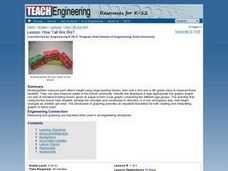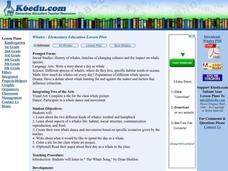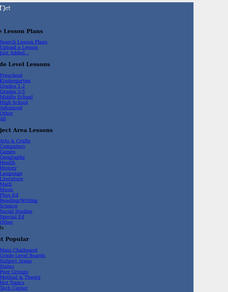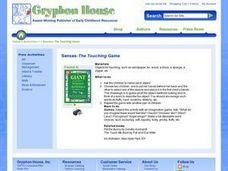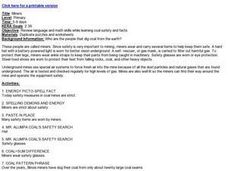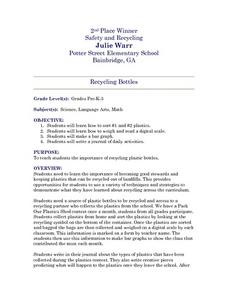Curated OER
Water Wonders
Young scholars measure the amount of surface tension using a balance scale after a classroom demonstration students diagram the appearance of several liquids and label them.
Curated OER
Crayon Resist
Kids usually love crayon resist projects. It is so fascinating for them to see how the dark paint accentuates and resists the waxy crayon. Here are instructions for executing a crayon resist project of your own. Tip: Make the project fit...
Curated OER
Add and Subtract with Hudson River shipping
Rivers aren't just a place for animals to live, they also provide industrial transportation. The class will examine the Hudson River on a map, discuss all the commercial vessels that use the River to transport materials, then complete a...
Curated OER
Com-Post With Us? Learn About Recycling While Having Fun
Young scholars examine the importance of recycling to help the environment. In groups, they make a compost bin on the school grounds recording how the material changes from week to week. They collect other materials for recycling like...
Curated OER
Rainforest
Students create a rainforest poster and move to music learning about the rainforest. For this rainforest lesson plan, students express themselves in a variety of ways using their knowledge of the rainforest. Activities include creating a...
Curated OER
Hibernating Hoopla
Students simulate hibernation with their stuffed animals. They predict the length of time of hibernation and type their math journal entries about sorting, graphing and draw pictures. They read bear hibernation stories.
Curated OER
A Day Full of Popcorn
Students use the "tool" popcorn with activities in Language Arts, Math, Social Studies, P.E., Music, Art, Science and EATING.
Curated OER
DAY AND NIGHT
Students use a lamp as the sun and his/her body as the earth. They rotate in different directions to explain how the earth moves around the sun. Using specific questions in their discussion, students discover the reasons for day and night.
Curated OER
The Nature of Mathematics
Young scholars work in groups to describe plants using numbers. In this number lesson, students use numbers to define plants and then use numbers to write descriptions of themselves.
Curated OER
Sharks
Second graders identify and analyze the many types of sharks that can be found in the Great Barrier Reef in Australia. They also identify what the sharks eat for food, their habitats, and their constuction to the environment and the food...
Curated OER
How Tall Are We?
Students in a Kindergarten class measure each other's height using large building blocks and then visit a 2nd and a 4th grade class to measure those students. They display the results in bar graphs, comparing the different age groups.
Curated OER
It Counts
Students understand and reinforce how numbers are assigned to objects, as well as think about more, less, or equal values. In this lesson, students are asked to describe, compare, and classify plants. They should be able to use numbers...
Curated OER
Daily Survival Requirements of Water
Students will use inquiry science to complete an investigation. They create hypotheses predicting the changes water undergoes in becoming ice and determine how much ice needs to be melted to create one 8 oz. glass of water.
Curated OER
Whales
Students study the history of whales. In this whale lesson plan, students research two types of whales, color a tile, and write a one page paper. The tiles may be combined to make a group picture.
Curated OER
How big is a whale
Students research the size of whales using print books or the internet. Students do the research in groups. They compare and graph the results.
Curated OER
Sink or Float?
Students predict and explore to discover which objects sink or float in fresh and salt water, predict how salt affect objects, write predictions on T chart, discuss difference between man-made and natural waters, and graph results.
Curated OER
Does the falling tree make a sound if no one if there to hear it? (or communication via encryption)
Students explore encryption. They discuss the importance of cryptography in our daily lives. Students use games and cryptography to discover transformational geometry and modulo systems. They design their own encryption puzzles and...
Curated OER
Winter Animal Match
Young scholars play a game. In this matching lesson, students learn about animals and their winter homes. Young scholars match cards of animals with the cards of winter homes.
Curated OER
Senses -- The Touching Game
Students practice making educated guesses about objects in their hands. They guess what the object is without looking at it and choose a word that describes it. They practice using new vocabulary as well.
Curated OER
Adaptable Mandibles
Young scholars define adaptation and highlight example of adaptation in birds and other animals. They study feeding techniques of seabirds and investigate the effect that trash has on wildlife.
Curated OER
Miners
Learners complete various activities related to mining and mining safety. They write an energy sentence, complete a word puzzle, cut and glue safety equipment on a mining character, solve a math code word puzzle, and complete a maze...
Curated OER
Recycling Bottles
Students learn how to sort #1 and #2 plastics and how to weigh and read a digital scale. The bags are then collected and weighed on a digital scale and the information is used to make bar graphs. They also write in their journal about...
Curated OER
How Much Do We SPend For Electricity?
Students investigate the concept of energy and focus upon the usage and the cost associated with it. They conduct research using a variety of resources while working in cooperative groups. Students graph the usage of energy as estimates...
Curated OER
Water Facts And Media
Students engage in a lesson plan that is concerned with the facts surrounding water. They conduct research using a variety of resources to gather facts for the game of trivia. The information is used also to create a group presentation.










